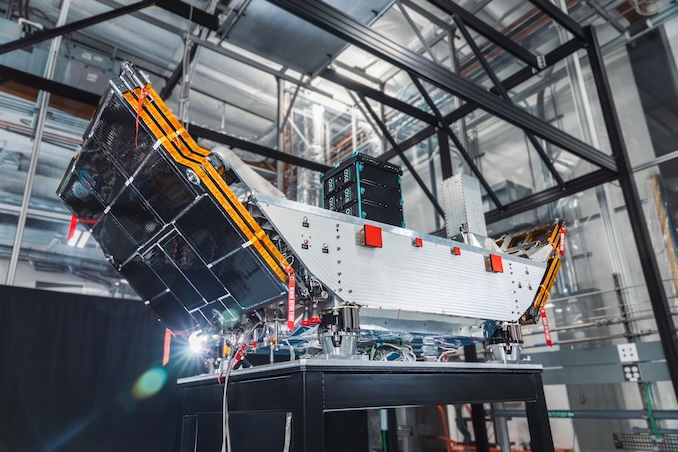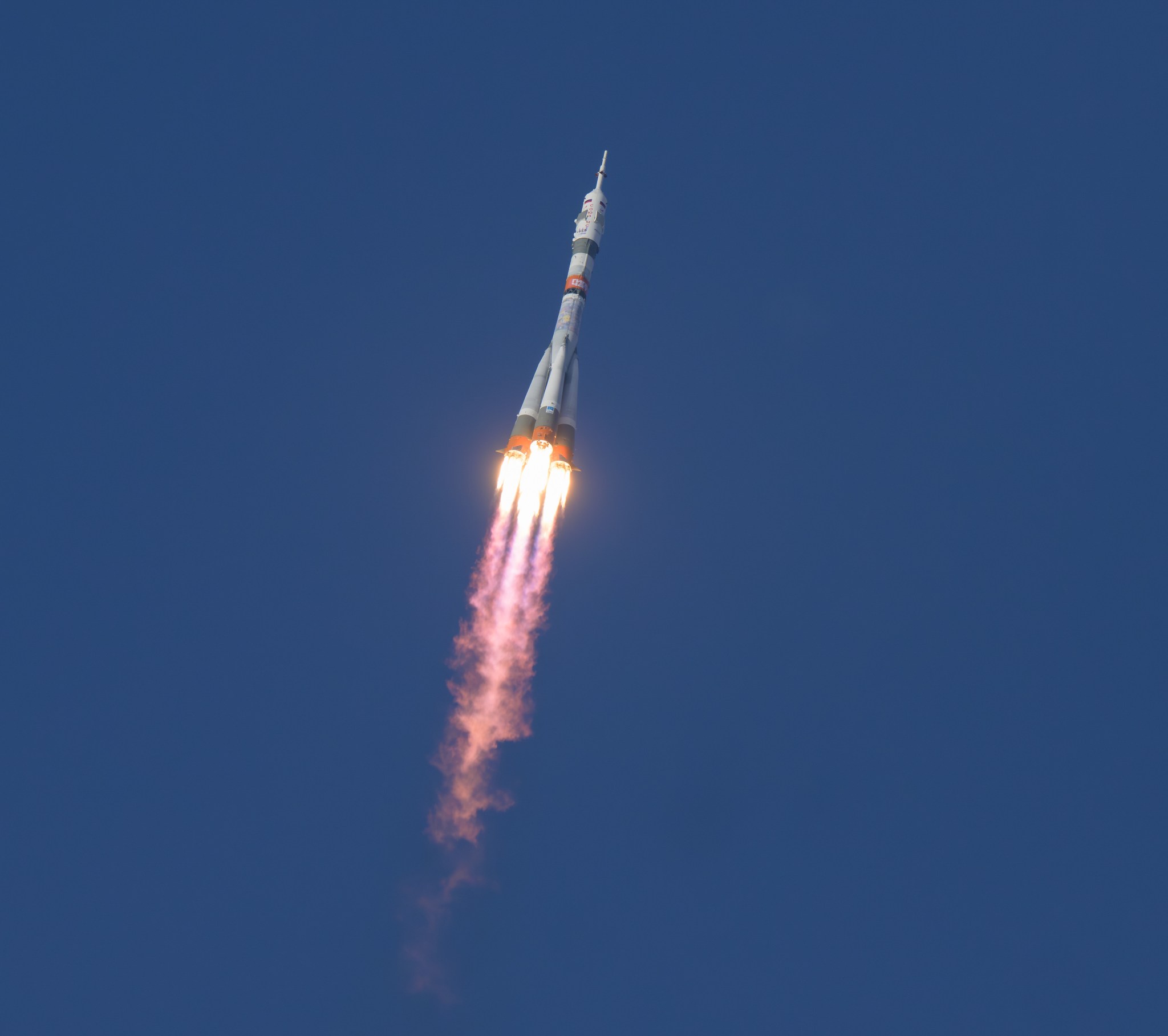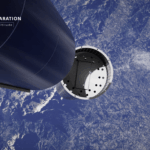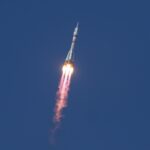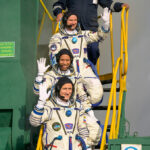Now Reading: NASA astronaut, two cosmonauts take Thanksgiving Day ride to space station
-
01
NASA astronaut, two cosmonauts take Thanksgiving Day ride to space station
NASA astronaut, two cosmonauts take Thanksgiving Day ride to space station

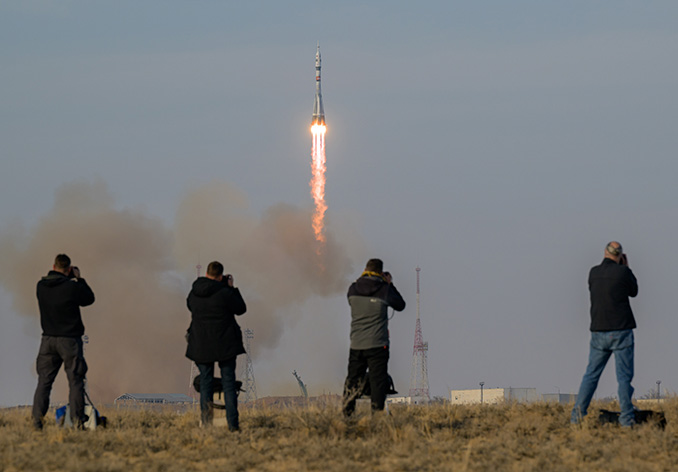
Astronomer-turned-medical physicist and now NASA astronaut Chris Williams joined two Russian cosmonauts aboard a Soyuz ferry ship Thursday for a Thanksgiving Day flight to the International Space Station, kicking off a planned eight-month stay in orbit.
With commander Sergey Kud-Sverchkov at the controls of the Soyuz MS-28/74S spacecraft, flanked on his left by flight engineer Sergey Mikaev and on the right by Williams, the crew’s Soyuz 2.1a booster roared to life at 4:27 a.m. EST and smoothly climbed away from the Baikonur Cosmodrome in Kazakhstan.
Nine minutes and 45 seconds later, the Soyuz spacecraft was released from the booster’s upper stage, its two solar wings unfolded and the crew set off after the space station. The automated two-orbit rendezvous ended with a docking at the lab’s Earth-facing Rassvet module at 7:34 a.m.
Williams, a one-time volunteer fight fighter and emergency medical technician with a Ph.D. in astrophysics from MIT, was a board-certified medical physicist at Harvard Medical School when selected to join NASA’s astronaut corps in 2021.
He and flight engineer Mikaev are making their first space flight while Kud-Sverchkov is a seasoned veteran, logging 185 days aboard the space station in 2020-2021.
“It’s a really great crew,” Williams said in a NASA interview. “Sergey and Sergey are both just absolutely wonderful people, really kind, super interested, super intellectually curious, which is really fun. Had a lot of really, really great discussions, just talking and talking about things.
“It’s been been wonderful to both spend some time with them over in Star City, and also to be able to spend some time with them in Houston through our training.”
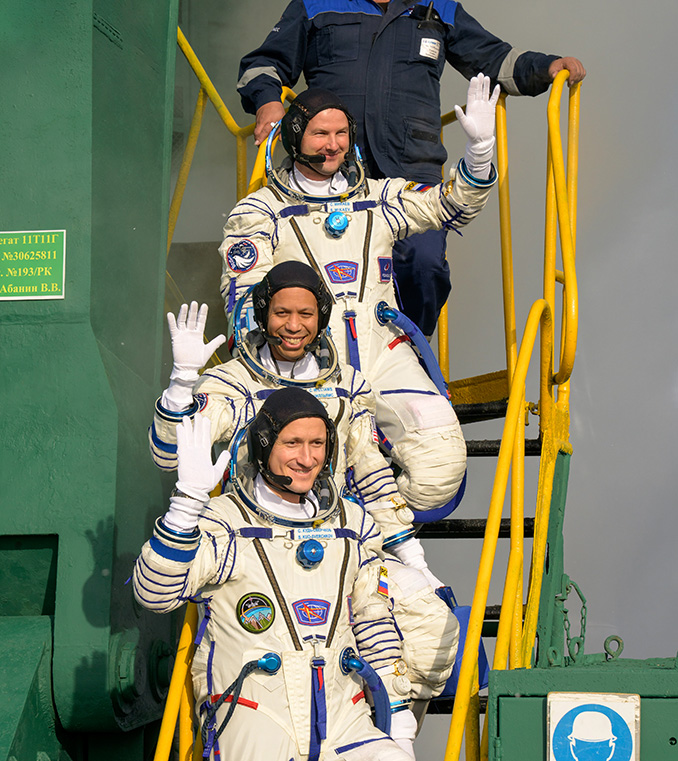
NASA astronaut Chris Williams, middle, and
Roscosmos cosmonaut Sergey Kud-Sverchkov, wave farewell prior to boarding the Soyuz MS-28 spacecraft for launch, Thursday, Nov. 27, 2025 at the Baikonur Cosmodrome in Kazakhstan. Launch of the Soyuz rocket will send the trio on a mission to the International Space Station. Photo: NASA/Bill Ingalls
The Soyuz MS-28 crew is replacing Soyuz MS-27/73S commander Sergey Ryzhikov, flight engineer Alexey Zubritsky and NASA astronaut Jonny Kim, who were launched to the space station last April 7. They plan to return to Earth in early December to wrap up an eight-month stay.
Also on hand to welcome Williams and his crewmates aboard the ISS: NASA Crew 11 commander Zena Cardman, Michael Fincke, Japanese astronaut Kimiya Yui and cosmonaut Oleg Platonov. They launched atop a SpaceX Falcon 9 rocket last August and plan to come home in February or March, after their replacements — Crew 12 — arrive.
All 11 station fliers planned to gather for a traditional welcome aboard video call to mission managers and family back in Moscow before a safety briefing and the start of familiarization with the space station’s complex systems.
Williams, an Eagle Scout with a private pilot’s license, is a standout in an astronaut office staffed with super achievers.
After graduating from Stanford University with a bachelor’s degree in physics, Williams was doing radio astronomy research on the way to a Ph.D. and “down the street from my house, there was a volunteer fire department. And I was like, oh, that sounds like something that could be kind of like fun and interesting to do.”
“So I started volunteering. Got trained as an EMT and a firefighter, and started just sort of doing that on a volunteer basis. And I found that I really liked it. I got a lot of satisfaction out of knowing that … at the end of the shift, I would have really made a very direct and immediate positive impact on somebody’s life.”
He kept that up throughout graduate school. Then, as he was winding up his doctorate in astrophysics, Williams said he ran into a doctor he knew at a party who told him there was “a big need for physicists in medicine, in particular, in radiation oncology, where we use radiation to treat cancer.”
He talked with a few other people, including one who had been an astronomer before switching to medical physics, and “I was struck by how much of what I knew and had learned as an astronomer would actually be useful and apply very directly to medicine.”
“A lot of the math behind (medical) imaging is the exact same math that actually you use in a radio telescope to make an image,” Williams said. “It was kind of neat to see that image processing techniques that I’d used as (a radio astronomer) actually carried over pretty directly into medicine.”
At the time of his selection as an astronaut, Williams was on the staff at Harvard Medical School as a clinical physicist and researcher. He is the second member of the 2021 class of astronauts to fly in space, getting assigned to the Soyuz MS-28 mission shortly after finishing astronaut candidate training.
He said the training for launch on a Russian spacecraft was difficult, primarily because of the travel required. He credited his wife, Aubrey, with keeping the family’s life on an even keel throughout.
As for what he looks forward to during his eight-month stay in space, Williams repeated a familiar theme.
“I’ve got a lot of different goals, but I think the biggest one, and the thing I’m most excited about, is to truly be able to put my training into practice and to do a really good job to push forward the science and research that we’re doing on on the space station.”
“I think it’s incredibly important. I think it’s incredibly interesting and incredibly inspiring, and I feel really lucky to have the opportunity to contribute to that.”
Stay Informed With the Latest & Most Important News
-
 012024 in Review: Highlights from NASA in Silicon Valley
012024 in Review: Highlights from NASA in Silicon Valley -
 02Panasonic Leica Summilux DG 15mm f/1.7 ASPH review
02Panasonic Leica Summilux DG 15mm f/1.7 ASPH review -
 03How New NASA, India Earth Satellite NISAR Will See Earth
03How New NASA, India Earth Satellite NISAR Will See Earth -
 04And Thus Begins A New Year For Life On Earth
04And Thus Begins A New Year For Life On Earth -
 05Astronomy Activation Ambassadors: A New Era
05Astronomy Activation Ambassadors: A New Era -
06SpaceX launch surge helps set new global launch record in 2024
-
 07Space Force plans new ‘Futures Command’ amid pressure to speed up modernization
07Space Force plans new ‘Futures Command’ amid pressure to speed up modernization













